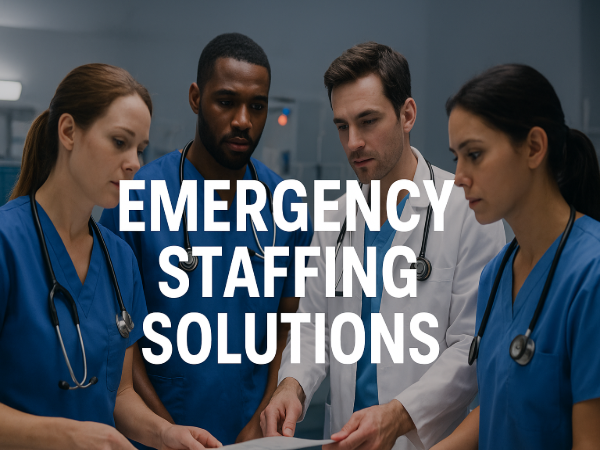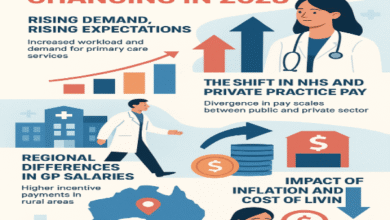Emergency Staffing Solutions: The Lifeline of Modern Healthcare Systems
How Emergency Staffing Solutions Ensure Continuity, Quality, and Patient Safety Amid Healthcare Workforce Shortages

In the fast-paced world of healthcare, emergency staffing solutions play a crucial role in ensuring uninterrupted patient care during unforeseen crises and staffing shortages. With over 139.8 million emergency room visits reported last year, hospitals rely on rapid-response staffing models to maintain quality care and operational efficiency. These solutions provide highly skilled professionals at short notice, bridging critical gaps in patient coverage while upholding safety and service standards.
Introduction: The Growing Need for Emergency Staffing Solutions
The healthcare industry thrives on precision, readiness, and the ability to adapt quickly. When staff shortages strike—whether due to illness, burnout, seasonal surges, or sudden emergencies—patient care can be severely compromised. This is where emergency staffing solutions become indispensable. They provide hospitals, clinics, and healthcare systems with immediate access to qualified personnel, ensuring care standards are not only maintained but often enhanced.
In today’s unpredictable world, staffing crises are no longer occasional events. From pandemics to natural disasters, healthcare facilities must remain prepared to respond efficiently. Emergency staffing solutions are not just about filling vacant shifts—they are about safeguarding lives through continuity of care.
Understanding Emergency Staffing Solutions
At its core, emergency staffing solutions refer to structured systems or services that enable healthcare institutions to deploy skilled professionals rapidly during times of staffing distress. These professionals might include nurses, physicians, emergency medical technicians, or support staff who can step into high-pressure environments with minimal orientation.
The flexibility of these solutions allows hospitals to adapt swiftly to dynamic patient volumes. Unlike traditional recruitment processes that take weeks or months, emergency staffing focuses on speed, quality, and compliance. Whether through internal float pools, staffing agencies, or locum tenens providers, these systems are the backbone of healthcare resilience.
Why Emergency Staffing Solutions Matter More Than Ever
The healthcare sector is facing a historic workforce shortage. The American Hospital Association reports persistent challenges in recruiting and retaining staff, especially in emergency and critical care units. Burnout, aging workforces, and increased patient demand have widened the staffing gap.
Emergency staffing solutions help bridge this gap by:
Ensuring patient safety even during crises.
Reducing burnout among permanent staff by providing support during high-demand periods.
Maintaining operational stability when absenteeism spikes.
Improving patient outcomes through timely care delivery.
With healthcare demands growing and patient expectations higher than ever, hospitals that leverage effective emergency staffing strategies stand out as both efficient and compassionate institutions.
Types of Emergency Staffing Solutions
Healthcare facilities use a variety of models to implement emergency staffing, each tailored to their operational needs and urgency levels.
Locum Tenens Professionals
These are temporary physicians or nurses who fill positions for short durations. They are often pre-credentialed and can be deployed rapidly, ensuring that critical departments never face coverage gaps.
Per Diem Staff
Per diem healthcare workers are hired on a day-to-day basis. This flexible workforce allows hospitals to adjust staff numbers according to patient volume and acuity.
Travel Nurses and Allied Health Professionals
Traveling healthcare professionals relocate temporarily to meet staffing demands across regions. They are essential in balancing workforce shortages in rural or understaffed areas.
On-Call and Float Pools
Many hospitals maintain a roster of cross-trained employees who can be called in during emergencies. These internal float pools reduce dependency on external agencies while ensuring seamless care delivery.
Crisis Response Teams
During large-scale emergencies like pandemics or natural disasters, crisis response staffing teams are deployed. These specialized units handle surge demands while maintaining compliance with healthcare standards.
The Process Behind Emergency Staffing
A well-structured emergency staffing program follows a series of key steps to ensure efficiency and quality.
Assessment of Needs: Hospitals evaluate staffing shortages and identify critical departments.
Activation Protocols: Emergency staffing triggers are set to initiate recruitment or deployment.
Credentialing and Verification: All temporary staff undergo strict credential checks to ensure competence.
Integration and Orientation: Quick onboarding ensures staff align with hospital protocols and technologies.
Performance Monitoring: Supervisors track quality, productivity, and patient satisfaction.
Feedback and Adjustment: Post-deployment evaluations improve future responses.
This process ensures that staffing solutions are both rapid and reliable, minimizing any risk of operational disruption.
Benefits of Emergency Staffing Solutions
Continuity of Care
Even in times of crisis, patient care must not suffer. Emergency staffing guarantees that hospitals maintain consistent care delivery without delays or compromises.
Reduced Burnout Among Staff
Overworked healthcare workers are prone to fatigue, which can lead to medical errors. Emergency staffing helps distribute workloads evenly, reducing stress and promoting well-being among permanent staff.
Enhanced Patient Safety and Satisfaction
Adequate staffing levels directly correlate with better patient outcomes, shorter wait times, and improved satisfaction scores.
Cost-Effective Flexibility
Instead of maintaining oversized permanent staff rosters, hospitals can use on-demand staffing to manage fluctuating workloads efficiently.
Specialized Skills Availability
Emergency staffing allows hospitals to access professionals with niche expertise when needed, such as trauma care or intensive care specialists.
Challenges in Implementing Emergency Staffing Solutions
While the benefits are immense, healthcare facilities face several challenges when deploying emergency staff.
High Costs: Rapid deployment often involves premium pay rates.
Credentialing Delays: Verification processes, if inefficient, can slow deployment.
Cultural Integration: Temporary staff may take time to adapt to a hospital’s environment.
Quality Assurance: Maintaining consistent care quality across mixed teams requires strong oversight.
Communication Barriers: Differences in work styles and communication can impact teamwork.
Despite these challenges, hospitals that adopt structured and well-managed staffing frameworks can overcome these obstacles effectively.
Technology’s Role in Emergency Staffing
Modern healthcare facilities are leveraging artificial intelligence, data analytics, and automation to predict staffing needs before they become critical.
Predictive Analytics
AI-driven models can forecast patient influx based on historical data, local trends, or seasonal illness patterns, allowing proactive staffing adjustments.
Automated Scheduling Systems
Digital platforms streamline shift management, matching staff availability with patient demand instantly.
Telemedicine Integration
Virtual support from remote clinicians helps balance workloads, particularly during night shifts or rural healthcare shortages.
Credentialing Databases
Centralized systems enable real-time verification, expediting deployment processes.
These technologies make emergency staffing more strategic, data-driven, and responsive.
How Emergency Staffing Supports Public Health During Crises
During large-scale public health emergencies—such as pandemics, natural disasters, or disease outbreaks—emergency staffing solutions become life-saving mechanisms.
They enable hospitals to:
Mobilize additional personnel swiftly.
Prevent care delays during patient surges.
Maintain emergency and critical care services at full capacity.
Coordinate multi-location response teams.
The COVID-19 pandemic showcased how critical these systems are. Facilities with established emergency staffing partnerships were far better equipped to handle patient surges and maintain care continuity.
Building a Successful Emergency Staffing Strategy
Hospitals looking to strengthen their resilience should invest in a well-rounded emergency staffing framework. The key components include:
Partnership with Trusted Staffing Agencies
Maintaining an Internal Float Pool
Regular Simulation Drills for Crisis Response
Continuous Data Analysis for Demand Forecasting
Employee Retention and Support Programs
Comprehensive Compliance and Training Initiatives
By combining proactive planning with flexible response systems, hospitals can ensure they never face a shortage that compromises patient safety.
Future of Emergency Staffing Solutions
The future of emergency staffing solutions is increasingly digital, predictive, and collaborative. Advances in artificial intelligence, cross-border staffing models, and telehealth integration are shaping a new era of healthcare flexibility.
Healthcare organizations are expected to focus on preventive staffing models, where data analytics predict demand weeks in advance. Moreover, global networks of healthcare professionals will allow cross-country support during crises—enhancing both readiness and resilience.
Ultimately, the future belongs to healthcare systems that view emergency staffing not as a backup plan, but as a strategic pillar for sustainable patient care.
Conclusion: The Lifeline of Healthcare Preparedness
Emergency staffing solutions have evolved from a temporary measure into a cornerstone of healthcare excellence. They empower institutions to adapt quickly, protect staff well-being, and ensure that patient safety never takes a back seat—even in the face of uncertainty.
As hospitals continue to navigate workforce challenges and rising patient demands, the integration of efficient emergency staffing systems will define the difference between reactive care and proactive excellence. In every sense, emergency staffing solutions are the heartbeat of a resilient healthcare system—steady, reliable, and essential.



